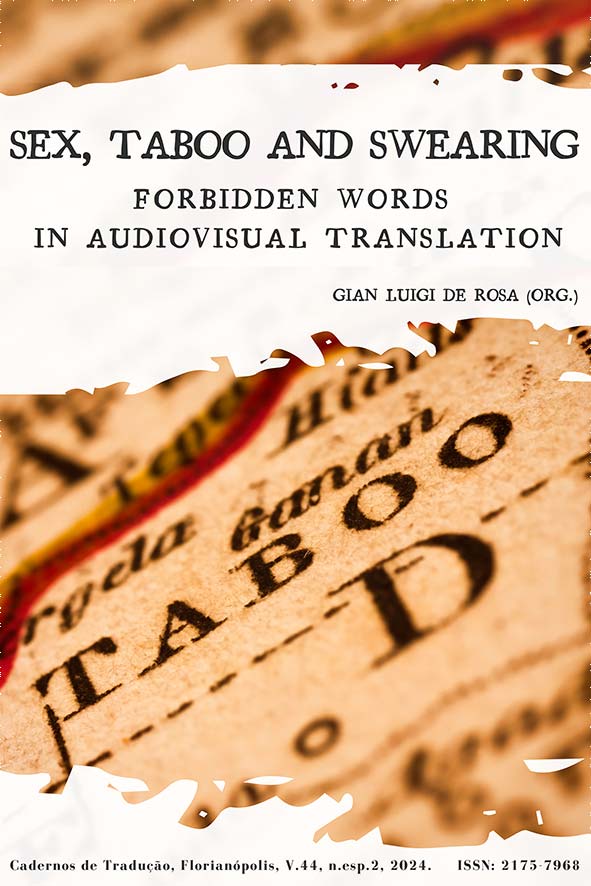Short films, coarse speech and subtitling: The case of Diez minutos (2004) and Dime que yo (2008)
DOI:
https://doi.org/10.5007/2175-7968.2024.e99178Keywords:
short films, coarse language, juvenile language, audiovisual translation, interlinguistic subtitlingAbstract
The essay analyses a corpus of two contemporary Spanish-language auteur short films: Diez minutos by Alberto Ruiz Rojo, released in Spain in 2004, and Dime que yo by Mateo Gil, shown four years later. Both belonging to a dramatic genre with some romantic nuances, the two filmic texts show - despite the different plots - a very recognizable colloquial juvenile language that includes a massive use of vulgar expressions and coarse speech. Since we do not have an official Italian translation, but only an English subtitling, we will subtitle in Italian the sequences in which this kind of language predominates, trying to compensate some linguistic and cultural losses. The aim of this work is not to reduce or to neutralize the use of swear words and vulgar forms, neither because of the reduction in the number of characters required for the practice of interlingual subtitling, nor for mere marketing reasons.
References
Apte, M. K. (1994). Taboo Words. In R. E. Asher (Ed.), The Encyclopedia of Language and Linguistics (pp. 4512–4515). Pergamon.
Ávila-Cabrera, J. J. (2014). The Subtitling of Offensive and Taboo Language: A Descriptive Study. [Tesis Doctoral]. Universidad Nacional de Educación a Distancia.
Ávila-Cabrera, J. J. (2023). The Challenge of Subtitling Offensive and Taboo Language into Spanish: A Theoretical and Practical Guide. Multilingual Matters.
Casabone, G. E. (2016). El lenguaje burocrático como género. Una lectura crítica sobre las escrituras de la modernidad. Oficios Terrestres, 1(35), 1–21.
Castro Roig, X. (1997). Breve nota sobre el papel del traductor de material televisivo. In E. Morillas & J. P. Arias (Eds.), El papel del traductor (pp. 419–422). Ediciones Colegio de España.
Contos Valdealgorfa. (2015). ‘Diez Minutos’ de Alberto Ruiz Rojo. Cortos Valdealgorfa. http://cortosvaldealgorfa.com/diez-minutos-alberto-ruiz-rojo/
De Miguel, E. (2000). El texto jurídico-administrativo: análisis de una orden ministerial. Círculo de Lingüística Aplicada a la Comunicación, 4, 53–80.
Devoto, G., & Oli, G. C. (2006). Dizionario della lingua italiana. Le Monnier.
Eco, U. (2003). Dire quasi la stessa cosa. Esperienze di traduzione. Bompiani.
Film Affinity España. (2024). Dime que yo (C). Film Affinity. https://www.filmaffinity.com/es/film858562.html
Fo, D. (2010). L’osceno è sacro. Guanda.
Garzelli, B. (2016). ‘Dime que yo’ de Mateo Gil. El cortometraje de autor como forma de narración en la didáctica del español LE. In E. Carpi, R. M. García Jiménez & E. Liverani (Eds.), Labirinti. Le forme del narrare, nel tempo e tra i generi. Volume I – Lingua (pp. 117–138). Università di Trento.
Garzelli, B. (2020). La traducción audiovisual español-italiano. Películas y cortos entre humor y habla soez. Peter Lang.
Gil, M. (Dirección). (2008). Dime que yo [Cortometraje]. User T38; Foro Sonoro; Platanutre. https://www.youtube.com/watch?v=t8XOj3W7D4M
Gómez Mompart, J. L. (2011). La explosión de la cultura oral. La Vanguardia. https://www.lavanguardia.com/opinion/temas-de-debate/20111106/54237853942/la-explosion-de-la-cultura-oral.html?page=1
Gottlieb, H. (1992). Subtitling – A New University Discipline. In C. Dollerup & A. Loddegaard (Eds.), Teaching Translation and Interpreting. Training, Talent and Experience (pp. 161–170). John Benjamins.
Gottlieb, H. (1994). Subtitling: Diagonal Translation. Perspectives, 2(1), 101–121. https://doi.org/10.1080/0907676X.1994.9961227
Hall, E. (1963). A System for the Notation of Proxemic Behavior. American Anthropologist, 65(5), 1003–1026. https://doi.org/10.1525/aa.1963.65.5.02a00020
IMDb. (2024a). Diez minutos. IMDb.com. https://www.imdb.com/title/tt0441205/
IMDb. (2024b). Dime que yo. IMDb.com. https://www.imdb.com/title/tt1409085/
López, X., & Gil, M. (2007). Di me que yo. https://dimequeyo.files.wordpress.com/2009/12/di-me-que-yo.pdf
Muñoz Carrión, A. (1998). Comunicación corporal -kinésica, proxémica-. In R. Reyes (Dir.), Diccionario Crítico de Ciencias Sociales (pp. 1–5). Euro-Mediterranean University Institute. https://www.theoria.eu/dictionary/C/comunicacion_corporal.pdf.
Pavesi, M. (2005). La traduzione filmica. Aspetti del parlato doppiato dall’inglese all’italiano. Carocci.
Pavesi, M., & Malinverno, A. L. (2000). Usi del turpiloquio nella traduzione filmica. In C. Taylor (Ed.), Tradurre il cinema (pp. 75–90). Università degli studi di Trieste.
Peña Alcarria, A. D. (2010, February 20). Crítica al cortometraje “Dime que yo”, de Mateo Gil, ganador del Goya al mejor cortometraje de ficción 2009. El Blog de Cine Español. http://www.elblogdecineespanol.com/?p= 1010.
Perego, E. (2005). La traduzione audiovisiva. Carocci.
Real Academia Española. (n.d.-a). Mequetrefe. In Diccionario de la Real Academia Española. https://dle.rae.es/mequetrefe?m=form
Real Academia Española. (n.d.-b). Puto. In Diccionario de la Real Academia Española. https://dle.rae.es/?w=puto&m=form
Ruiz Rojo, A. (Dirección). (2004). Diez minutos [Cortometraje]. Art Ficción Producciones. http://www.youtube.com/watch?v=ZD8JjSjR3X0.
Tam, L. (2004). Grande dizionario di spagnolo. Hoepli.
Tartaglione, R., & Grassi, G. (1985). Lingue italiane: materiale didattico per un corso superiore di lingua e cultura italiana. Ci.elle.i.
Vocabolario Treccani. (n.d.). Rómpere. In Vocabolario Treccani. Istituto dell’Enciclopedia Italiana. https://www.treccani.it/vocabolario/rompere/
Downloads
Published
How to Cite
Issue
Section
License
Copyright (c) 2024 Cadernos de Tradução

This work is licensed under a Creative Commons Attribution 4.0 International License.
Copyright Notice
Authors hold the copyright and grant the journal the right for their articles' first publication, being their works simultaneously licensed under the Creative Commons Attribution License (CC BY), which allows the sharing of such works with its authorship acknowledged and its initial publication in this journal.
Authors are allowed to enter into separate additional contractual arrangements for the non-exclusive distribution of the journal's published version of the work (e.g., post it to an institutional repository or as a book chapter, with an acknowledgment of its initial publication in this journal).






















































